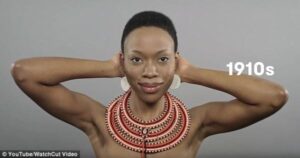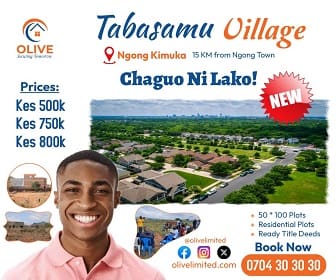
A stunning new videos offers a glimpse into Kenya’s changing political and cultural climates by chronicling the evolving styles of its women from the start of British colonization to Kenyan actress Lupito Nyong’o’s rise to fame.
The time-lapse video, which is part of Cut.com’s 100 Years of Beauty series, stars model Keesee Andrea, who is transformed again and again by a team of make-up artists and hair stylists recreating the East African country’s most popular beauty trends of the last ten decades.
Beginning in the 1910s, Keesee is morphed into a bare-faced beauty modeling dramatic jewelry, and the clip ends with the model emulating Lupito, who took home her first Oscar in 2014.
Changing times: A beautiful new video shows the evolution of female beauty in Kenya over the past century starting with the traditional jewelry worn by woman in the 1910s
Traditional style: A girl of the Masai people of East Africa is pictured wearing tribal jewelry in the early 20th century
To represent the 1910s, Cut.com’s team of beauty experts pull Keesee’s hair back and leave her face bare.
An intricately beaded African necklace adorns her neck while circular beaded earrings hang from her ears.
In 1895, the British Empire established the East Africa Protectorate of the land that is roughly known as present-day Kenya, however, the look from the 1910s depicts traditional Kenyan beauty at the start of colonization.
In the 1920s, Britain the East Africa Protectorate was renamed the Colony and Protectorate of Kenya, and this decade saw an abundance of immigrants from other British colonies, including many people from India who were involved in the construction of the railway that was being built.
However, the ongoing British colonial projects resulted in a tremendous loss of land, displacing rural populations, as well as forced labor of the native Kenyans.
Plaited hair: Dreadlocks became a symbol of the struggle for emancipation and independence from colonialism in the 1920s
Added elements: The model’s hair buns, beaded jewelry, and septum piercing is inspired by a photo of two Nubian women from the 1930s
According to the The SAGE Encyclopedia of African Cultural Heritage in North America, dreadlocks ‘had become a part of the culture of people of African descent in the diaspora during the journey on slave ships, when combing and grooming hair were impossible’.
Dreadlocks became a symbol of the struggle for emancipation and independence from colonialism, and to represent female beauty in Kenya in the 1920s, Cut.com‘s stylists braid Keesee’s hair into six thick plaits.
The model’s face was left relatively bare, and her dreads are paired only with a long beaded necklace.
The crash of the US stock market in 1929 marked the start of a a world wide depression that hit commodity prices globally and led to economic and political tensions in colonial Kenya.
By the 1930s, approximately 30,000 white settlers lived in Kenya, and the colonial government often suppressed campaigns for more African representation in legislation.
Covered up: The silk scarf worn to represent Kenyan beauty in the 1940s is a replica of the ones worn by Nubian family from that era
Updo: The model’s hair is pulled back into a tight bun, and stone earrings hang from her ears in this Kenyan beauty look from the 1950s
More modern look: A Kenyan nurse Florence Mugone is pictured speaking with Lady Olave Baden-Powell at the Commonwealth Institute in London at a display of tapesty panels depicting life in Kenya in 1961
Keesee’s look for the ’30s is inspired by a photo of two Nubian women from the era.
Like the women in the photo, Keesee’s hair is parted down the middle and styled into two buns, one on each side of her face.
She wears a beaded necklace and dangling earrings, as well as a hoop earring in her septum, a piercing that is prevalent among warrior cultures.
For the 1940s, Keesee’s hair remains in two low buns, but her head is covered by a patterned scarf, a look inspired by a portrait of a Nubian family from that decade.
The women in the image are dressed in both traditional and modern styles as the beauty from that period continued to evolve into a mix of old and new.
The next decade marked the start of the Mau Mau Uprising in 1952, which lasted until 1960. The Mau Mau was an African nationalist group that opposed British colonial rule.
For Keesee’s portrayal of 1950s beauty in Kenya, her hair is pulled back into a tight bun, and stone earrings hang from her ears.
Elegant style: The model’s towering updo representing the 1960s was worn popularized by Josephine Moikobu, who was named Miss Kenya in 1968
Beloved figure: The headscarf-updo worn by Kenya’s first ever First Lady, ‘Mama’ Ngina Kenyatta, serves as the inspiration for female beauty in the 1970s
Rising star: The big hair and purple eye shadow representing the 1980s was inspired by Kenyan model Khadija Adams, who covered Cosmopolitan magazine in 1986
Although the look is similar to the style worn by women in the US in the 1950s, the earrings are reminiscent of more traditional Kenyan jewelry.
By 1963, Kenya had gained independence, which led to numerous political, economic, and social, changes.
As an independent country, Kenyans were able to compete in the Olympics and international beauty pageants for the first time.
Keesee’s look for the 1960s is inspired by Josephine Moikobu, who was named Miss Kenya in 1968.
In the clip, stylists tease and wrap her hair to create the towering updo worn by Josephine during that decade.
Kenya’s newfound freedom continued to dictate the style of the times, and Keesee represents the 1970s by wearing an elegant headscarf updo that was worn by Kenya’s first ever Firsy Lady, ‘Mama’ Ngina Kenyatta, who was known for her style and grace.
A decade later, Khadija Adams, who was named Miss Kenya in 1984, went on to have a successful modeling career, which included serving as a muse for iconic designer Yves Saint Laurent and a 1986 cover of Cosmopolitan.
Beauty queen: The model can be seen emulating the curly updo and bright make-up worn by Esther Muthoni Muthee, who was named Miss Kenya in 1999
Global look: The female style of beauty in Kenya during the 2000s included frosty eye shadow colors, shiny lip gloss, and thinly tweezed eyebrows
Khadija’s voluminous long hair, dramatic purple eye shadow, and diamond necklace, serves as the inspiration for Keesee’s representation of Kenyan beauty in the 1980s.
A decade later brought on the success of commercial FM radio in Kenya, and music greatly influenced the style of the 1990s.
To represent the time, Cut.com‘s stylists put Keesee’s hair into an intricate updo featuring curly tendrils parted to the side, similar to the style worn by Esther Muthoni Muthee, who was Miss Kenya in 1999.
Keesee’s hairstyle was paired with pink eye shadow and glossy lips, which would become even more popular a decade later.
The female style of beauty in Kenya during the 2000s was extremely similar to popular looks in the US, which included frosty eye shadow colors, the rise of mineral make-up, shiny lip gloss, and thinly tweezed eyebrows.
International star: For the final decade in the clip, the model’s hair is left natural and cropped to emulate actress Lupita Nyong’o, who was raised in Kenya
Rising star: The bright make-up worn to represent modern-day Kenyan beauty (left) was inspired by the Oscar winning actress. Lupita (right) is pictured at the 2016 Met Gala earlier this month
Kenyan pop star Amani optimized the style of times, and Keesee perfectly emulates her blue eye shadow, glossy purple lips to represent the start of the new century.
For the final decade in the clip, Keesee’s hair is left natural and cropped to emulate Lupita Nyong’o, who was raised in Kenya.
Lupita gained world-wide recognition after she won an Academy Award in 2014 for her role in 12 Years a Slave.
The actress, who was named an ambassador of Lancome in 2015, is known for her natural, cropped hair, and bright make-up.
Inspired by Lupita’s many red carpet looks, Keesee’s make-up features bold purple shadow, long, curled eyelashes, and bright pink lips that pop against her dark skin
Photos/Video: Model shows how beauty trends in Kenya over 100 years from colonization to the rise of Lupita Nyong’o









